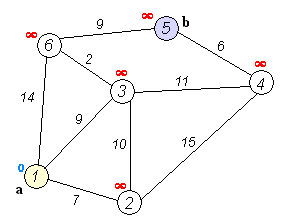贝尔曼-福特算法(Bellman–Ford algorithm)
贝尔曼-福特算法是求解单源最短路径问题的一种算法,由 Richard Bellman \text{Richard Bellman} Richard Bellman Lester Ford \text{Lester Ford} Lester Ford Moore-Bellman-Ford \text{Moore-Bellman-Ford} Moore-Bellman-Ford Edward F. Moore \text{Edward F. Moore} Edward F. Moore ∣ V ∣ − 1 {\displaystyle |V|-1} ∣ V ∣ − 1 O ( ∣ V ∣ ∣ E ∣ ) {\displaystyle O(|V||E|)} O ( ∣ V ∣∣ E ∣ )
迪杰斯特拉算法(Dijkstra’s algorithm)
算法思想
Dijkstra \text{Dijkstra} Dijkstra Dijkstra \text{Dijkstra} Dijkstra G = < V , E > {\displaystyle G=<V,E>} G =< V , E > Dijkstra \text{Dijkstra} Dijkstra S {\displaystyle S} S S {\displaystyle S} S s {\displaystyle s} s u ∈ V − S {\displaystyle u\in {V-S}} u ∈ V − S u {\displaystyle u} u S {\displaystyle S} S Dijkstra \text{Dijkstra} Dijkstra WikiPedia )
过程模拟
设d i s [ i ] dis[i] d i s [ i ] v 0 v_0 v 0 v i v_i v i d i s [ 1 ] , d i s [ 2 ] , ⋯ , d i s [ 8 ] dis[1],dis[2] ,\cdots ,dis[8] d i s [ 1 ] , d i s [ 2 ] , ⋯ , d i s [ 8 ] d i s [ i ] dis[i] d i s [ i ] d i s [ 0 ] = 0 , v i s [ 0 ] = 1 dis[0]=0,vis[0]=1 d i s [ 0 ] = 0 , v i s [ 0 ] = 1 d i s [ 1 ] = 1 dis[1]=1 d i s [ 1 ] = 1 v 1 v_1 v 1 v 1 v_1 v 1 v 2 , v 3 , v 4 v_2,v_3,v_4 v 2 , v 3 , v 4 d i s [ 2 ] = d i s [ 1 ] + w [ 1 ] [ 2 ] = 4 dis[2]=dis[1]+w[1][2]=4 d i s [ 2 ] = d i s [ 1 ] + w [ 1 ] [ 2 ] = 4 d i s [ 3 ] = d i s [ 1 ] + w [ 1 ] [ 3 ] = 8 dis[3]=dis[1]+w[1][3]=8 d i s [ 3 ] = d i s [ 1 ] + w [ 1 ] [ 3 ] = 8 d i s [ 4 ] = d i s [ 1 ] + w [ 1 ] [ 4 ] = 6 dis[4]=dis[1]+w[1][4]=6 d i s [ 4 ] = d i s [ 1 ] + w [ 1 ] [ 4 ] = 6 d i s [ 2 ] dis[2] d i s [ 2 ] d i s [ 2 ] = 5 dis[2]=5 d i s [ 2 ] = 5 d i s [ 2 ] = 4 < 5 dis[2]=4<5 d i s [ 2 ] = 4 < 5 v 2 v_2 v 2 v 2 v_2 v 2 v 4 , v 5 v_4,v_5 v 4 , v 5 d i s [ 4 ] = 5 , d i s [ 5 ] = 11 dis[4]=5,dis[5]=11 d i s [ 4 ] = 5 , d i s [ 5 ] = 11 d i s [ 4 ] dis[4] d i s [ 4 ] d i s [ 3 ] dis[3] d i s [ 3 ] v 1 , v 2 v_1,v_2 v 1 , v 2 v 4 v_4 v 4 d i s [ 3 ] dis[3] d i s [ 3 ] d i s [ 3 ] = 7 dis[3]=7 d i s [ 3 ] = 7 v i s [ 4 ] = 1 vis[4]=1 v i s [ 4 ] = 1 ⋯ ⋯ \cdots\cdots ⋯⋯ d i s [ 8 ] dis[8] d i s [ 8 ] v 0 v_0 v 0 d i s [ i ] dis[i] d i s [ i ] d i s [ i ] dis[i] d i s [ i ]
例题
Description
Bessie is out in the field and wants to get back to the barn to get as much sleep as possible before Farmer John wakes her for the morning milking. Bessie needs her beauty sleep, so she wants to get back as quickly as possible.N N N ( 2 ⩽ N ⩽ 1000 ) (2\leqslant N\leqslant 1000) ( 2 ⩽ N ⩽ 1000 ) 1.. N 1..N 1.. N 1 1 1 N N N T T T ( 1 ⩽ T ⩽ 2000 ) (1\leqslant T\leqslant 2000) ( 1 ⩽ T ⩽ 2000 )
Line 1: Two integers: T T T N N N
Output
Line 1: A single integer, the minimum distance that Bessie must travel to get from landmark N N N 1 1 1
5 5
Sample Output
90
Hint
There are five landmarks.
OUTPUT DETAILS
Bessie can get home by following trails 4, 3, 2, and 1.
Translation
一张图有t t t n n n 1 1 1 n n n
Code
1 2 3 4 5 6 7 8 9 10 11 12 13 14 15 16 17 18 19 20 21 22 23 24 25 26 27 28 29 30 31 32 33 34 35 36 37 38 39 40 41 42 43 44 45 46 47 48 49 50 51 52 53 54 55 56 57 58 59 60 61 62 63 #include <iostream> #include <cstring> #include <algorithm> #define N 1002 #define inf 0x3f3f3f3f using namespace std;int G[N][N];int t,n;bool vis[N];int dis[N];void dijkstra () int i,j; for (i=1 ;i<=n;i++) dis[i]=G[1 ][i]; int res,pos; vis[1 ]=1 ; for (i=1 ;i<=n;i++) { res=inf; for (j=1 ;j<=n;j++) { if (res>dis[j]&&!vis[j]) { pos=j; res=dis[j]; } } vis[pos]=1 ; for (j=1 ;j<=n;j++) { if (!vis[j]&&dis[j]>dis[pos]+G[pos][j]) { dis[j]=dis[pos]+G[pos][j]; } } } cout<<dis[n]<<endl; } void solve () memset (G,inf,sizeof (G)); cin>>t>>n; int i; for (i=1 ;i<=n;i++) G[i][i]=0 ; while (t--) { int u,v,w; cin>>u>>v>>w; G[u][v]=min (G[u][v],w); G[v][u]=min (G[v][u],w); } dijkstra (); } int main () solve (); return 0 ; }
优化
链式前向星优化
能极大降低空间复杂度,由于链式前向星可以存两点之间的很多边,所以不需要考虑去重边。
1 2 3 4 5 6 7 8 9 10 11 12 13 14 15 16 17 18 19 20 21 22 23 24 25 26 27 28 29 30 31 32 33 34 35 36 37 38 39 40 41 42 43 44 45 46 47 48 49 50 51 52 53 54 55 56 57 58 59 60 61 62 63 64 65 66 67 68 69 70 71 72 73 74 #include <iostream> #include <cstring> #include <algorithm> #define N 5300 using namespace std;int head[N];int tot;struct E { int to; int Next; int w; }edge[N]; void add_edge (int from,int to,int w) tot++; edge[tot].to=to; edge[tot].w=w; edge[tot].Next=head[from]; head[from]=tot; } int t,n;bool vis[N];int dis[N];void dijkstra () int i,j; memset (dis,0x3f ,sizeof (dis)); memset (vis,0 ,sizeof (vis)); int res,pos; dis[1 ]=0 ; for (i=1 ;i<=n;i++) { res=0x3f3f3f3f ; for (j=1 ;j<=n;j++) { if (res>dis[j]&&!vis[j]) { pos=j; res=dis[j]; } } vis[pos]=1 ; for (j=head[pos];j!=-1 ;j=edge[j].Next) { int y=edge[j].to; if (!vis[y]&&dis[y]>dis[pos]+edge[j].w) { dis[y]=dis[pos]+edge[j].w; } } } cout<<dis[n]<<endl; } void solve () memset (head,-1 ,sizeof (head)); cin>>t>>n; while (t--) { int u,v,w; cin>>u>>v>>w; add_edge (u,v,w); add_edge (v,u,w); } dijkstra (); } int main () solve (); return 0 ; }
堆优化
堆优化可将时间复杂度降至O ( ( m + n ) log n ) O((m+n)\log n) O (( m + n ) log n )
1 2 3 4 5 6 7 8 9 10 11 12 13 14 15 16 17 18 19 20 21 22 23 24 25 26 27 28 29 30 31 32 33 34 35 36 37 38 39 40 41 42 43 44 45 46 47 48 49 50 51 52 53 54 55 56 57 58 59 60 61 62 63 64 65 66 67 68 69 70 71 72 73 74 75 76 77 78 79 80 81 82 83 84 85 #include <iostream> #include <cstring> #include <vector> #include <queue> #define N 5044 using namespace std;int head[N];int tot;struct cmp { template <typename T> bool operator () (T const & left,T const & right) { if (left.second>right.second) return true ; else return false ; } }; struct E { int to; int Next; int w; }edge[N]; void add_edge (int from,int to,int w) tot++; edge[tot].to=to; edge[tot].w=w; edge[tot].Next=head[from]; head[from]=tot; } int t,n;bool vis[N];int dis[N];void dijkstra () int i,j; memset (dis,0x3f ,sizeof (dis)); memset (vis,0 ,sizeof (vis)); int res,pos; dis[1 ]=0 ; priority_queue<pair<int ,int >,vector<pair<int ,int > >,cmp>q; q.push (make_pair (1 ,0 )); while (!q.empty ()) { pair<int ,int >res; res=q.top (); q.pop (); int from=res.first; vis[from]=1 ; for (j=head[from];j!=-1 ;j=edge[j].Next) { int to=edge[j].to; if (!vis[to]&&dis[to]>dis[from]+edge[j].w) { dis[to]=dis[from]+edge[j].w; q.push (make_pair (to,dis[to])); } } } cout<<dis[n]; } void solve () memset (head,-1 ,sizeof (head)); cin>>t>>n; while (t--) { int u,v,w; cin>>u>>v>>w; add_edge (u,v,w); add_edge (v,u,w); } dijkstra (); } int main () solve (); return 0 ; }
模板
题目描述
给定一个 n n n m m m s s s s s s
输入格式
第一行为三个正整数 n , m , s n, m, s n , m , s m m m u i , v i , w i u_i, v_i, w_i u i , v i , w i u i u_i u i v i v_i v i w i w_i w i
输出格式
输出一行 n n n s s s
输入输出样例
输入 #1
4 6 1
输出 #1
0 2 4 3
说明/提示
1 ≤ n ≤ 1 0 5 1 \leq n \leq 10^5 1 ≤ n ≤ 1 0 5 1 ≤ m ≤ 2 × 1 0 5 1 \leq m \leq 2\times 10^5 1 ≤ m ≤ 2 × 1 0 5 1 ≤ u i , v i ≤ n 1 \leq u_i, v_i\leq n 1 ≤ u i , v i ≤ n 0 ≤ ∑ w i ≤ 1 0 9 0 \leq \sum w_i \leq 10 ^ 9 0 ≤ ∑ w i ≤ 1 0 9
代码
1 2 3 4 5 6 7 8 9 10 11 12 13 14 15 16 17 18 19 20 21 22 23 24 25 26 27 28 29 30 31 32 33 34 35 36 37 38 39 40 41 42 43 44 45 46 47 48 49 50 51 52 53 54 55 56 57 58 59 60 61 62 63 64 65 66 67 68 69 70 71 #include <cstdio> #include <algorithm> #include <queue> #define N 100002 using namespace std;struct E { int to; int w; int Next; }edge[N<<1 ]; int head[N],tot;int dis[N];bool vis[N];int n,m,s;inline void add (int u,int v,int w) tot++; edge[tot].to=v; edge[tot].w=w; edge[tot].Next=head[u]; head[u]=tot; } struct node { int id; int dis; bool operator <(const node &x)const { return x.dis<dis; } }; void dijkstra () fill (dis,dis+1 +n,0x7fffffff ); dis[s]=0 ; int i; priority_queue<node>q; q.push ((node){s,0 }); while (!q.empty ()) { node now=q.top (); q.pop (); int x=now.id; if (vis[x]) continue ; vis[x]=1 ; for (i=head[x];~i;i=edge[i].Next) { int y=edge[i].to; if (!vis[y]&&dis[y]>dis[x]+edge[i].w) { dis[y]=dis[x]+edge[i].w; q.push ((node){y,dis[y]}); } } } for (i=1 ;i<=n;i++) printf ("%d " ,dis[i]); } int main () scanf ("%d%d%d" ,&n,&m,&s); fill (head,head+n+1 ,-1 ); while (m--) { int u,v,w; scanf ("%d%d%d" ,&u,&v,&w); add (u,v,w); } dijkstra (); return 0 ; }

















